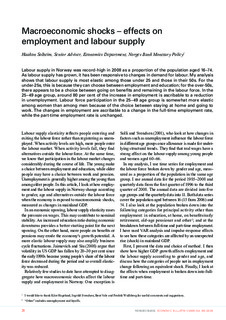| dc.contributor.author | Solheim, Haakon | |
| dc.date.accessioned | 2018-07-03T07:37:35Z | |
| dc.date.available | 2018-07-03T07:37:35Z | |
| dc.date.issued | 2009 | |
| dc.identifier.issn | 1503-8831 | |
| dc.identifier.uri | http://hdl.handle.net/11250/2504097 | |
| dc.description.abstract | The labour supply in Norway was record-high in 2008. As the labour supply has grown, it has been responsive to changes in demand for labour. The analysis shows that labour supply is most elastic among those under 25 and those in their 50s. This is because these groups can choose between employment and education or benefits respectively. Labour force participation in the 25–50 age group is somewhat more elastic among women than among men because of the choice between staying at home and going to work. The changes in employment are ascribable to a change in the full-time employment rate, while the part-time employment rate is unchanged. | nb_NO |
| dc.language.iso | eng | nb_NO |
| dc.publisher | Norges Bank | nb_NO |
| dc.rights | Attribution-NonCommercial-NoDerivatives 4.0 Internasjonal | * |
| dc.rights.uri | http://creativecommons.org/licenses/by-nc-nd/4.0/deed.no | * |
| dc.title | Macroeconomic Shocks – Effects on Employment and Labour Supply | nb_NO |
| dc.type | Journal article | nb_NO |
| dc.subject.nsi | VDP::Samfunnsvitenskap: 200::Økonomi: 210::Samfunnsøkonomi: 212 | nb_NO |
| dc.source.pagenumber | 28-38 | nb_NO |
| dc.source.journal | Economic Bulletin | nb_NO |
| dc.source.issue | 1/2009 | nb_NO |

